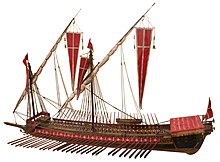Galley

A galley is a type of ship. Galleys use rowing to move. The first galleys were using in Ancient Egypt, during the Old Kingdom (c. 2700-2200 BCE). Long ago, people like the Egyptians and Cretans used boats with sails for fighting and trading.[1] The Phoenicians were among the first to make a boat called a bireme around 700 BC. It had two sets of oars on each side, one above the other, so they wouldn't hit each other. They later added another set of oars outside the first two, making a ship called a trireme, around 500 BC. Some writings talk about ships with even more sets of oars, like the quinquireme, but these were probably just very big ships with two or three sets of oars.
Structure and Mechanism[change | change source]
By the time of ancient Rome, war boats were very different from merchant ships. The war boats had long, skinny bodies and pointed fronts for ramming other ships. Merchant ships were wider and deeper, and they relied more on sails. Eventually, ships that only used sails became common. But even in medieval times, war boats called galleys were still used for trade, although they were more expensive to run because they needed bigger crews. The Vikings had small galleys called longships that could hold around 50 or 60 people. Places like Byzantium, Venice, and Genoa built fancier galleys, which were like big, decorated war boats. By the 13th century, Italian galleys were sailing to places like England and Africa for trade. In 1291, two Genoese galleys were lost while trying to find a new sea route to the Indies.
Later on, new kinds of sails and steering made galleys less useful for trading, but they were still important in battles until the 16th century. They were especially important in the Battle of Lepanto in 1571.[2]
- ↑ "Galley | Ship, History, Features & Uses | Britannica". www.britannica.com. 2024-03-18. Retrieved 2024-05-08.
- ↑ "Galley | Ship, History, Features & Uses | Britannica". www.britannica.com. 2024-03-18. Retrieved 2024-05-08.
